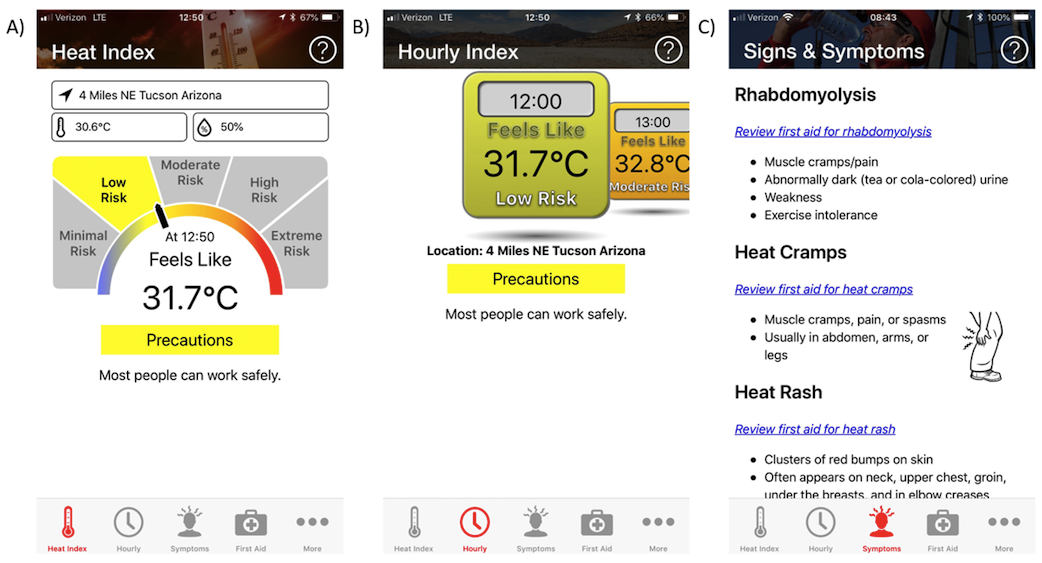By Franck Brocherie @BrocherieF, Sébastien Racinais @ephysiol
APP REVIEW
NAME OF THE MOBILE APPLICATION
Heat Safety Tool
CATEGORY OF THE MOBILE APPLICATION
Weather, Sports Medicine
PLATFORM
iOS 9.0 or later. Compatible with iPhone, iPad and iPod touch; Android – 4.3 and up.
COST
Free.
ABOUT THE APP
According to the Occupational Safety and Health Administration (OSHA), extreme heat causes more deaths than any other weather-related hazard. Heat-related illnesses represent a spectrum of disorders due to environmental exposure to heat. Its severity scale continuum includes minor (ie, heat rash, syncope and cramps) to serious (ie, heat exhaustion, injury and stroke) conditions.1,2 Vigilance about heat-related illness has become even more important as overall temperatures continue to rise, which is generally attributed to climate change.
Aiming to help individuals (eg, vulnerable individuals such as elderly and children, but also workers, landscapers, farmers and exercisers) staying safe outdoor in hot weather, the Centers for Disease Control and Prevention, National Institute for Occupational Safety and Health (NIOSH) redesigned the OSHA’s original Heat Safety Tool as a free app for smartphones and other mobile devices. The app uses the device’s Global Positioning system (GPS) to extract temperature and relative humidity data from National Oceanic and Atmospheric Administration satellites to determine the heat index. Unfortunately, it currently appears to only work in USA. If the area you live in is not covered by the app, there is an option to manually enter the ambient temperature and relative humidity to get a “feel like” heat index and the associated risk estimation. Based on the current calculated risk level (low, moderate, high or extreme) rated using a color scale (from white through red), the app provides users with specific NIOSH and OSHA recommendations (eg, drinking enough fluids, scheduling rest breaks, recognizing and monitoring heat illness signs and symptoms, planning for and knowing what to do in case of an emergency) for proper heat safety precautions.3 In addition, the app forecasts the hourly heat index throughout the entire day, and includes links to information about heat-related illness signs and symptoms.
USE IN CLINICAL PRACTICE
The main concern with such apps is that environmental heat stress is not equivalent to human heat strain.4,5 Human thermoregulatory responses depend on the heat production (eg, activity intensity) / dissipation (eg, acclimation, clothing) balance. The app also lacks an individual setting that could include possible factors favoring heat-related illnesses’ development. For example, age (>40 yr), gender (male), ethnic (Caucasian), obesity (body mass index >30 kg·m−2), low physical fitness levels, dehydration, sunburn, non-heat acclimatization, sleep deprivation, previous history of exertional heat-related injury, sweat gland dysfunction, sickle cell trait, viral illness, diarrhea and certain medications (eg, antidepressant) are factors increasing the risk of heat-related illness.
Overall, this app is a useful educational resource which provides a reasonable framework to assist users to safely monitor and manage heat stress. Distribution of such material by sports medicine clinicians, associated practitioners and social media can help us to beat the heat!
PROS:
- Free app;
- Uses GPS to determine position and collect weather data;
- Identifies the current risk undertaken by users;
- Puts heat-related life-saving information at the fingertips;
- User-friendly interface; and
- Multiple language support (English and Spanish).
CONS:
- The app’s GPS function does not work abroad (currently USA only);
- Unable to select different weather and heat stress indices (eg, most sporting federation actually use the Wet-Bulb Globe Temperature index);
- Lack of activity/sports setting; and
- Lack of individual user’s setting.

Figure 1:Screenshot of Heat Safety Tool interface, showing (A) the heat index using location, (B) hourly heat index view to plan outdoor exposition/activity; and (C) signs and symptoms.
***
Competing interests
None declared
Franck Brocherie @BrocherieF is Senior researcher at the French Institute of Sport (INSEP) in Paris, France. His research interest mainly focuses on the impact of the environmental stress (heat and/or altitude) on exercise-induced fatigue development. He is frequently invited as speaker or consultant with individual- and team-sport professional squads and Olympic/Paralympic federations concerning innovative environmental training and acclimation/acclimatation to challenging conditions. Franck is also member of the European Network in Sports Sciences (ENSS) in environmental physiology. Email: franck.brocherie@insep.fr
Sébastien Racinais @ephysiol is the head of the Athlete Health and Performance research centre at Aspetar in Doha, Qatar. He is also a senior associate editor for BJSM and leads the European Network in Sports Sciences (ENSS) in environmental physiology. He has published more than 100 original research articles, review papers and book chapters in this area. Dr Racinais has successfully guided over 20 professional and national teams in developing environmental training and is collaborating with international sports federations (including IOC, UCI and IAAF) on consensus guidelines relating to exercising in hot ambient conditions. Email: sebastien.racinais@aspetar.com
References:
- Brocherie F, Girard O, Millet G. Emerging Environmental and Weather Challenges in Outdoor Sports. Climate2015;3(3):492.
- Leon LR, Bouchama A. Heat stroke. Compr Physiol2015;5(2):611-47. doi: 10.1002/cphy.c140017 [published Online First: 2015/04/17]
- Jacklitsh B, Williams WJ, Musolin K, et al. NIOSH criteria for a recommended standards. In: NIOSH, ed. Cincinnati, OH: US: Department of Health and Human Services, Centers for Disease Control and Prevention, National Institute for Occupational Safety and Health, DHHS (NIOSH), 2016.
- Racinais S, Alonso JM, Coutts AJ, et al. Consensus recommendations on training and competing in the heat. Br J Sports Med2015;49(18):1164-73. doi: 10.1136/bjsports-2015-094915 [published Online First: 2015/06/13]
- Sawka MN, Leon LR, Montain SJ, et al. Integrated physiological mechanisms of exercise performance, adaptation, and maladaptation to heat stress. Compr Physiol2011;1(4):1883-928. doi: 10.1002/cphy.c100082 [published Online First: 2011/10/01]